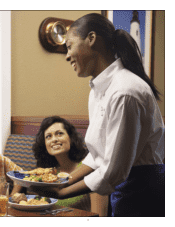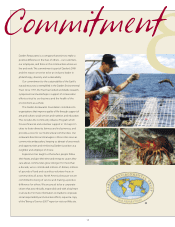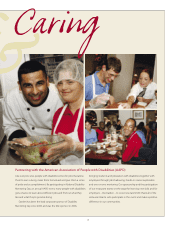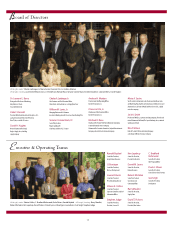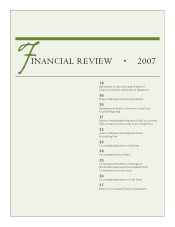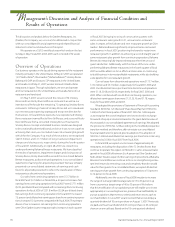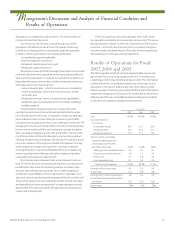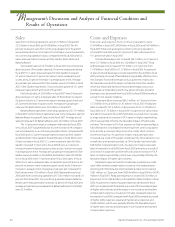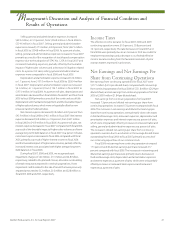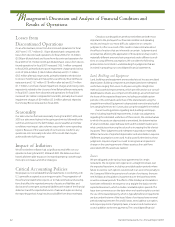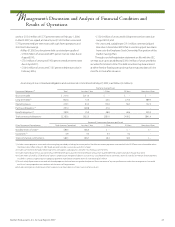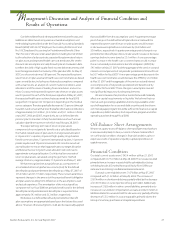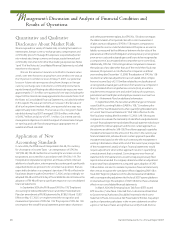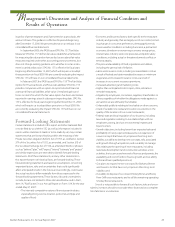Red Lobster 2007 Annual Report Download - page 21
Download and view the complete annual report
Please find page 21 of the 2007 Red Lobster annual report below. You can navigate through the pages in the report by either clicking on the pages listed below, or by using the keyword search tool below to find specific information within the annual report.
M
Darden Restaurants, Inc. Annual Report 2007 19
Management’s Discussion and Analysis of Financial Condition and
Results of Operations
declaration, our indicated annual dividend is 72 cents per share, an
increase of more than 56 percent.
Our mission is to be the best in casual dining, now and for
generations. We believe we can achieve this goal by continuing
to build on our strategy to be a multi-brand casual dining growth
company, which is grounded in four strategic pillar areas:
• Competitively superior leadership;
• Brand management excellence;
• Restaurant operating excellence; and
• Restaurant support excellence.
We seek to increase profits by leveraging our fixed and semi-fixed
costs with sales from new restaurants and increased guest traffic and
sales at existing restaurants. To evaluate our operations and assess our
financial performance, we monitor a number of operating measures,
with a special focus on two key factors:
• Same-restaurant sales – which is a year-over-year comparison
of each period’s sales volumes for restaurants open at least
16 months; and
• Restaurant earnings – which is restaurant-level profitability
(restaurant sales, less restaurant-level cost of sales, marketing
and depreciation).
Increasing same-restaurant sales can increase restaurant
earnings because these incremental sales provide better leverage
of our fixed and semi-fixed costs. A restaurant concept can generate
same-restaurant sales increases through increases in guest traffic,
increases in the average guest check, or a combination of the two. The
average guest check can be impacted by menu price changes and by
the mix of menu items sold. For each restaurant concept, we gather
daily sales data and regularly analyze the guest traffic counts and the
mix of menu items sold to aid in developing menu pricing, product
offerings and promotional strategies. We view same-restaurant guest
counts as a measure of the long-term health of a restaurant concept,
while increases in average check and menu mix may contribute
more significantly to near-term profitability. We focus on balancing
our pricing and product offerings with other initiatives to produce
sustainable same-restaurant sales growth.
We compute same-restaurant sales using restaurants open at
least 16 months because new restaurants experience an adjustment
period before sales levels and operating margins normalize. Sales
at newly opened restaurants generally do not make a significant
contribution to profitability in their initial months of operation. Our
sales and expenses can be impacted significantly by the number and
timing of the opening of new restaurants and the closing, relocation
and remodeling of existing restaurants. Pre-opening expenses each
period reflect the costs associated with opening new restaurants in
current and future periods.
There are significant risks and challenges that could impact
our operations and ability to increase sales and earnings. The casual
dining restaurant industry is intensely competitive and sensitive to
economic cycles and other business factors, including changes in
consumer tastes and dietary habits. Other risks and uncertainties are
discussed below in Forward-Looking Statements.
Results of Operations for Fiscal
2007, 2006 and 2005
The following table sets forth selected operating data as a percent-
age of sales from continuing operations for the 52-week periods
ended May 27, 2007, May 28, 2006 and May 29, 2005. This information
is derived from the consolidated statements of earnings, found
elsewhere in this report. Additionally, this information and the
following analysis have been presented with the results of operations,
impairment charges and closing costs for Smokey Bones, Rocky River
Grillhouse and the nine closed Bahama Breeze restaurants classified
as discontinued operations for all periods presented.
Fiscal Years
2007 2006 2005
Sales 100.0% 100.0% 100.0%
Costs and expenses:
Cost of sales:
Food and beverage 29.0 29.3 29.9
Restaurant labor 32.5 32.2 32.1
Restaurant expenses 15.0 15.1 14.9
Total cost of sales, excluding
restaurant depreciation and
amortization of 3.3%, 3.4%
and 3.6%, respectively 76.5% 76.6% 76.9%
Selling, general and administrative 9.6 9.4 9.4
Depreciation and amortization 3.6 3.7 3.9
Interest, net 0.7 0.8 0.9
Asset impairment, net 0.1 0.0 0.0
Total costs and expenses 90.5% 90.5% 91.1%
Earnings before income taxes 9.5 9.5 8.9
Income taxes (2.7) (2.9) (2.9)
Earnings from continuing operations 6.8 6.6 6.0
Losses from discontinued operations,
net of taxes (3.2) (0.3) (0.2)
Net earnings 3.6% 6.3% 5.8%






